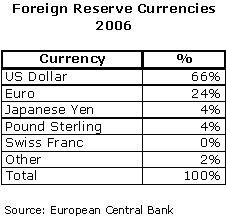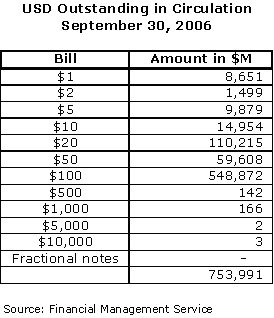When you travel around the world nowadays, it's not uncommon to find that a currency, like the U.S. dollar (USD), has become very engrained in a country's economy. While official dollarization may be well-documented, the murky world of unofficial dollarization is not. Read on to learn more about unofficial dollarization, why it has become so popular and how U.S. dollars move in and out of the United States. (For background reading, see Dollarization Explained.)
OverviewDuring the eighteenth and nineteenth centuries, the British pound reigned as the world's reserve currency but in the twentieth century, the U.S. dollar laid claim to this title. It has been the dominant reserve currency since the end of World War II.
Dollarization is a generic term that can fall into three categories:
1. Official Dollarization: The dollar is the only legal tender; there is no local currency. Examples of this can be seen in Panama, El Salvador and Ecuador. For example, since independence in 1903, Panama has only used the U.S. dollar. Surprisingly, the U.S. government does not have to provide approval for another country to use its currency as legal tender.
2. Semi-Dollarization: A country will use both its own currency and the U.S. dollar interchangeably as legal tender. Lebanon and Cambodia are good examples of this.
3. Unofficial Dollarization: For many countries in the developing world, the dollar will be widely used and accepted in private transactions, but it is not classified as legal tender by the country's government.
While many people associate dollarization with the U.S. dollar, the association is not exclusive. The euro, South African rand, Russian ruble, New Zealand dollar and Australian dollar are also accepted outside their countries, although in a localized nature. For example, the Russian ruble is accepted in a number of the countries from the old Soviet Union.
 Why is the U.S. dollar the currency of choice?
Why is the U.S. dollar the currency of choice?Stability is one of the major factors that explains why a number of countries have adopted the U.S. dollar as official currency. The U.S. dollar has never been devalued, and its notes have never been invalidated. For countries all too familiar with bank failures, devaluation and inflation, the stability of the U.S. dollar brings with it a certain amount of peace of mind. Business is easier to conduct when a stable currency is used.
Unofficial dollarization can be so prevalent in some countries that more U.S. currency is in circulation than local currency. Once this happens, it can be difficult to reverse. Ironically, the very stability that dollarization brings can be a curse to local governments, as they lose the power to control inflation and fiscal policy. However, to many, what is a curse to the government is a blessing to others.
In their paper, "Currency Substitution - Unofficial Dollarization and Estimates of Foreign Currency Held Abroad", Feige, Faulend, Sonje and Sosic estimate that 40-60% of existing U.S. dollars circulate outside of the United States. This estimate is supported by the actions of U.S. federal agencies, which produced posters and pamphlets in 24 languages to highlight the new look and anti-counterfeiting features of updated bills produced between 2003 and 2006.

Money is only valuable if it is acceptable. Therefore, the U.S. dollar is not without its problems. For example, $100 bills have a reputation of being vulnerable to counterfeiting. As a result, they also tend to be the ones that are most rejected or discounted around the world. Long gone are the days when bills denominated in $500, $1,000, $5,000 and even $10,000 circulated because money launderers love large bills. This also represents the final attraction of the U.S. dollar: anonymity. While the U.S. dollar is accepted around the world, it's not necessarily tracked well around the world.
How do all those dollars get overseas?To get a better handle on how many U.S. dollars are outside of the U.S., the U.S. Customs Service tracks information on cross-border flows through its Currency and Monetary Instrument Reports (CMIR). It's the most important source of information on the movement of U.S. dollars. Large financial institutions specialize in the transportation of large wholesale bulk shipments of U.S. dollars. The shipper must record on the CMIR, the size, origin and destination of the shipment. The opposite happens when U.S. dollars are sent back through the same intermediary. Cross border flows also entail retail shipments of amounts greater than $10,000. This area is made up of currency retailers, corporations and individuals physically transporting currency. The final category is individuals (i.e. travelers) that fall below the $10,000 filing threshold, as their shipments do not require a CMIR report. Next time you enter or leave the U.S., check the customs form for this reference.
ConclusionThis article should have helped unveil some of the mystery of unofficial dollarization. It's a topic that comes up repeatedly with international travelers and business people. Stability, acceptability and anonymity are all reasons why the U.S. dollar has become the world's currency of choice. Despite its popularity, however, don't become too enamored with the U.S. dollar, as no currency has held onto the title of "currency of choice" forever.